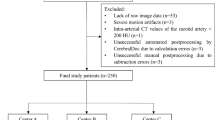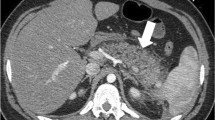Abstract
Objective
To evaluate the diagnostic performance of 18F-FDG PET/CT in the detection of stent graft infection (SGI).
Methods
In a retrospective study, two nuclear medicine physicians have independently analyzed 17 18F-FDG PET/CT examinations performed for clinical suspicion of SGI. The images were evaluated for the uptake pattern and intensity, and by the maximum standard uptake value (SUVmax), the target-to-background ratio with blood pool (TBRBP) and liver uptake (TBRhep) as a reference. The SGI was defined as the presence of focal hyperactivity with an intensity exceeding hepatic uptake. CT images were independently assessed for signs of SGI. Clinical review of all further patients’ data served as the standard of reference.
Results
Nine cases were established as SGI by the clinical review. PET/CT correctly diagnosed SGI in eight and yielded a sensitivity of 89% and specificity of 100%. The mean SUVmax, TBRBP, and TBRhep values were 9.8 ± 4.0, 6.9 ± 2.6, and 4.6 ± 1.7 in the group of patients with true SGI, and 4.0 ± 1.1, 2.5 ± 0.4 (p < 0.001) and 1.9 ± 0.2 (p < 0.001) in true negative cases, respectively. CT alone showed a sensitivity of 78% and specificity of 100% and was concordant with PET/CT in 14 cases. The best performing threshold values of SUVmax, TBRBP, and TBRhep were 5.6, 3.5, and 2.2, respectively.
Conclusion
18F-FDG PET/CT with expert evaluation, semiquantitative and quantitative image analysis with the proposed threshold values for SUVmax, TBRBP, and TBRhep has good diagnostic accuracy in the detection of SGI. We propose that visual grading scale for SGI should use hepatic uptake as a visual reference.


Similar content being viewed by others
References
Wilson WR, Bower TC, Creager MA, Amin-Hanjani S, O’Gara PT, Lockhart PB, et al. Vascular graft infections, mycotic aneurysms, and endovascular infections: a scientific statement from the american heart association. Circulation. 2016;134:e412–60.
Setacci C, Chisci E, Setacci F, Ercolini L, de Donato G, Troisi N, et al. How to diagnose and manage infected endografts after endovascular aneurysm repair. Aorta (Stamford). 2014;2:255–64.
Ilyas S, Shaida N, Thakor AS, Winterbottom A, Cousins C. Endovascular aneurysm repair (EVAR) follow-up imaging: the assessment and treatment of common postoperative complications. Clin Radiol. 2015;70:183–96.
Piffaretti G, Rivolta N, Mariscalco G, Tozzi M, Maida S, Castelli P. Aortic endograft infection: a report of 2 cases. Int J Surg. 2010;8:216–20.
Pandey N, Litt HI. Surveillance imaging following endovascular aneurysm repair. Semin Interv Radiol. 2015;32:239–48.
Speziale F, Calisti A, Zaccagnini D, Rizzo L, Fiorani P. The value of technetium-99m HMPAO leukocyte scintigraphy in infectious abdominal aortic aneurysm stent graft complications. J Vasc Surg. 2002;35:1306–7.
Spacek M, Belohlavek O, Votrubova J, Sebesta P, Stadler P. Diagnostics of “non-acute” vascular prosthesis infection using 18F-FDG PET/CT: our experience with 96 prostheses. Eur J Nucl Med Mol Imaging. 2009;36:850–8.
Wassélius J, Malmstedt J, Kalin B, Larsson S, Sundin A, Hedin U, et al. High 18F-FDG uptake in synthetic aortic vascular grafts on PET/CT in symptomatic and asymptomatic patients. J Nucl Med. 2008;49:1601–5.
Bruggink JLM, Glaudemans AWJM, Saleem BR, Meerwaldt R, Alkefaji H, Prins TR, et al. Accuracy of FDG-PET-CT in the diagnostic work-up of vascular prosthetic graft infection. Eur J Vasc Endovasc Surg. 2010;40:348–54.
Cernohorsky P, Reijnen MMPJ, Tielliu IFJ, van Sterkenburg SMM, van den Dungen JJAM, Zeebregts CJ. The relevance of aortic endograft prosthetic infection. J Vasc Surg. 2011;54:327–33.
Saleem BR, Berger P, Vaartjes I, de Keizer B, Vonken E-JPA, Slart RHJA, et al. Modest utility of quantitative measures in (18)F-fluorodeoxyglucose positron emission tomography scanning for the diagnosis of aortic prosthetic graft infection. J Vasc Surg. 2015;61:965–71.
Berger P, Vaartjes I, Scholtens A, Moll FL, De Borst GJ, De Keizer B, et al. Differential FDG-PET uptake patterns in uninfected and infected central prosthetic vascular grafts. Eur J Vasc Endovasc Surg. 2015;50:376–83.
Sah B-R, Husmann L, Mayer D, Scherrer A, Rancic Z, Puippe G, et al. Diagnostic performance of 18F-FDG-PET/CT in vascular graft infections. Eur J Vasc Endovasc Surg. 2015;49:455–64.
Tokuda Y, Oshima H, Araki Y, Narita Y, Mutsuga M, Kato K, et al. Detection of thoracic aortic prosthetic graft infection with 18F-fluorodeoxyglucose positron emission tomography/computed tomography. Eur J Cardio-Thorac Surg. 2013;43:1183–7
Rutherford RB, Baker JD, Ernst C, Johnston KW, Porter JM, Ahn S, et al. Recommended standards for reports dealing with lower extremity ischemia: revised version. J Vasc Surg. 1997;26:517–38.
Boellaard R, Delgado-Bolton R, Oyen WJG, Giammarile F, Tatsch K, Eschner W, et al. FDG PET/CT: EANM procedure guidelines for tumour imaging: version 2.0. Eur J Nucl Med Mol Imaging. 2015;42:328–54.
Meignan M, Gallamini A, Meignan M, Gallamini A, Haioun C. Report on the first international workshop on interim-PET-scan in lymphoma. Leuk Lymphoma. 2009;50:1257–60.
Walter MA, Melzer RA, Schindler C, Müller-Brand J, Tyndall A, Nitzsche EU. The value of [18F]FDG-PET in the diagnosis of large-vessel vasculitis and the assessment of activity and extent of disease. Eur J Nucl Med Mol Imaging. 2005;32:674–81.
Saleem BR, Pol RA, Slart RHJA, Reijnen MMPJ, Zeebregts CJ. 18F-Fluorodeoxyglucose positron emission tomography/CT scanning in diagnosing vascular prosthetic graft infection. BioMed Res Int. 2014. https://doi.org/10.1155/2014/471971
Arnaoutoglou E, Kouvelos G, Koutsoumpelis A, Patelis N, Lazaris A, Matsagkas M. An update on the inflammatory response after endovascular repair for abdominal aortic aneurysm. Mediat Inflamm. 2015. https://doi.org/10.1155/2015/945035
Acknowledgements
This study was supported by the First Faculty of Medicine, Charles University under Progres Q28/LF1 and UNCE 204065.
Author information
Authors and Affiliations
Corresponding author
Ethics declarations
Conflict of interest
The other authors declare that they have no conflict of interest.
Additional information
Publisher's Note
Springer Nature remains neutral with regard to jurisdictional claims in published maps and institutional affiliations.
Rights and permissions
About this article
Cite this article
Zogala, D., Rucka, D., Ptacnik, V. et al. How to recognize stent graft infection after endovascular aortic repair: the utility of 18F-FDG PET/CT in an infrequent but serious clinical setting. Ann Nucl Med 33, 594–605 (2019). https://doi.org/10.1007/s12149-019-01370-9
Received:
Accepted:
Published:
Issue Date:
DOI: https://doi.org/10.1007/s12149-019-01370-9




